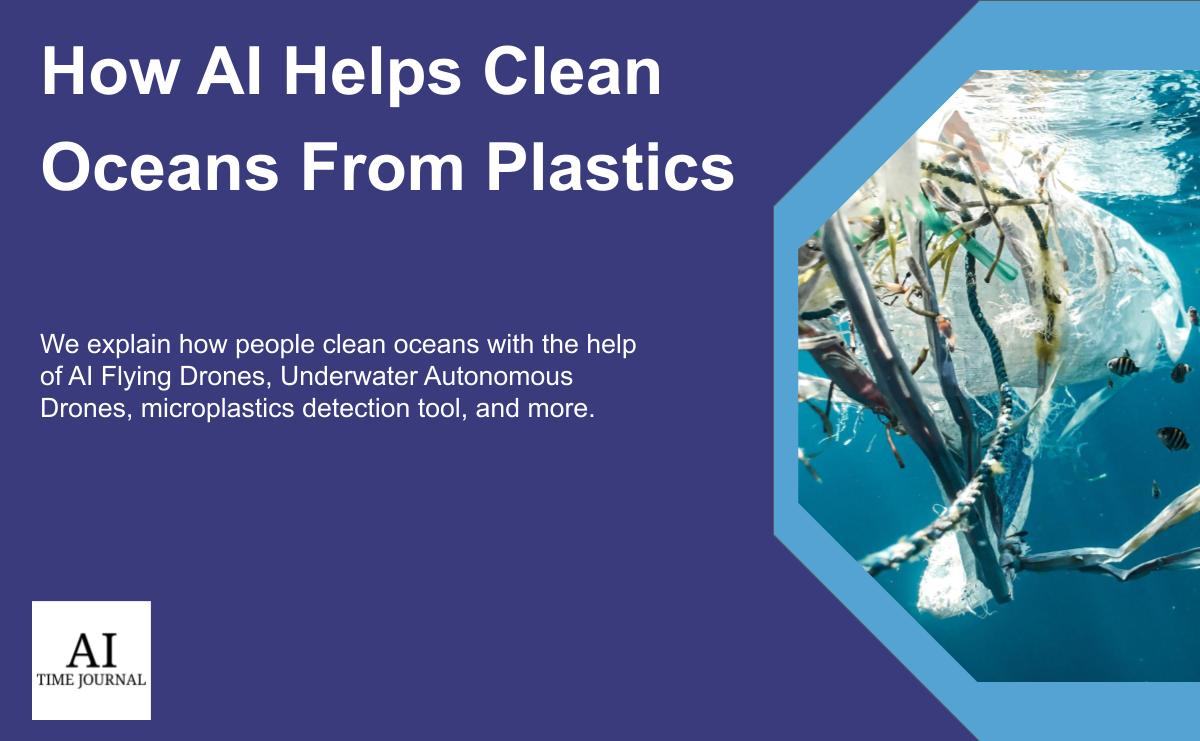
Oceans are severely polluted by plastics. It is a huge environmental problem that affects marine life and water quality and destroys natural habitats for many animals. Therefore, governments, non-governmental organizations (NGOs), and individuals passionate about saving our planet engage in various activities to clean oceans from plastics. In this post, we will talk about How AI helps clean oceans!
But, can Artificial Intelligence help people in their fight for clean oceans? It turns out that it can. AI can not only help clean oceans and rivers but can improve environmental sustainability as well.
To learn more about how AI can preserve sustainability, you can check this article: 5 Ways AI can Improve Environmental Sustainability.
In this article, we dig deeper into the benefits AI brings to the ocean-cleaning processes and talk about its potential in the field. Additionally, we discuss the use of AI in cleaning water objects such as lakes or rivers and improving water quality.
AI can help clean oceans in these ways:
- Analyze images to tackle plastic waste movement
- Distinguish plastic from marine inhabitants
- Collect rubbish from the sea bottom
- Detect microplastics
Let’s look deeper into each of them.
AI Flying Drones
One of the biggest problems people face when trying to clean oceans is the difficulty in tracking marine litter. Hence, various types of AI drones help people fight plastic pollution. Flying drones take photos of the examined area. After that, machine learning algorithms analyze these images to detect possible locations of plastic waste and highlight these areas on the map. Additionally, machine learning algorithms are trained to detect plastic rubbish, such as bottle tops or plastic bags, effectively distinguishing them from sea inhabitants like jellyfish.
A non-profit organization called The Ocean Cleanup, after two years of hard work, has developed an AI object detection software. This technology, in combination with GPS-tagged images and automated time-lapse series, allows us to detect and locate large masses of floating plastic waste remotely.
Underwater Autonomous Robots
Underwater autonomous robots can reach sea bottoms and unforeseen depths. With the help of such machines, it is now possible to find large pieces of plastic or trash lying on the ocean floor or traveling underwater. In this case, researchers and volunteers can now clean up debris and monitor pollution.
Underwater robots can also collect rubbish in an area of interest. Such robots are usually equipped with specific tools, such as a gripper or a suction device. Robots pick up litter from the ocean with the help of these tools and bring it to a specific “trash can” located on the bottom. After the cleaning process is finished, these baskets with plastics and other rubbish are brought to the surface.
These autonomous robots also help in tackling litter, but this time on the seafloor. However, in this case, factors such as underwater streams, the sinking speed of an item, and also specific forms of underwater reliefs (e.g., canyons) influence the garbage detection process.
Microplastics Detection
The microplastics (MPs) problem is one of the greatest challenges people face when it comes to ocean cleaning. Some plastic objects break into small pieces that are called microplastics. The main difficulty is that they cannot be cleaned or detected in the water. However, fish and other forms of marine life see these pieces of material and often mistake them for food. After that, people consume fish, and microplastics enter their bodies. Therefore, this problem related to ocean plastics directly affects people’s lives and remains unsolved.
However, researchers suggested new approaches to microplastic detection with the help of ML methods. For example, one of the recently developed techniques for MP identification is based on advanced machine-learning techniques and microscopy. In addition, AI has been trained to identify plastic cells. To learn more about how AI identifies and classifies cells, read this article.
Moreover, on the basis of fluorescent microscopy techniques, researchers can develop cost-effective and fast methods of MP detection. In addition, distinguishing microplastics from non-plastic objects becomes much easier. It is achieved by using a simple model powered by machine learning that helps classify materials according to their fluorescent coloration.
AI For Rivers
According to various estimations, approximately 95% of plastic travels into oceans from 10 large rivers, which are generally located in Asia. Hence, cleaning rivers is also a way to help remove plastics from oceans. The fewer artificial materials rivers have, the fewer plastics will reach our oceans.
Several tech graduates in Hong Kong have created an AI-enabled robotic boat that can clean rivers, harbors, and canals. It is not as large as the machines used for ocean cleaning. Therefore, this robot is more convenient for use on small or narrow water objects. Like the previously mentioned technologies, this boat can recognize the types of trash it collects and locate the cleaned area on a map. This AI-enabled robotic boat can bring nearly a metric ton of litter daily for recycling or disposal. An additional function it possesses is the ability to define areas polluted by oil or fuel and collect 15 liters of these pollutants daily.
In a nutshell, AI can help clean oceans from plastics in many ways. Moreover, it allows people to expand their abilities in water cleaning by helping detect microplastics. In addition, some technologies can clean various water objects not only from plastics but from other materials and substances that harm nature.
